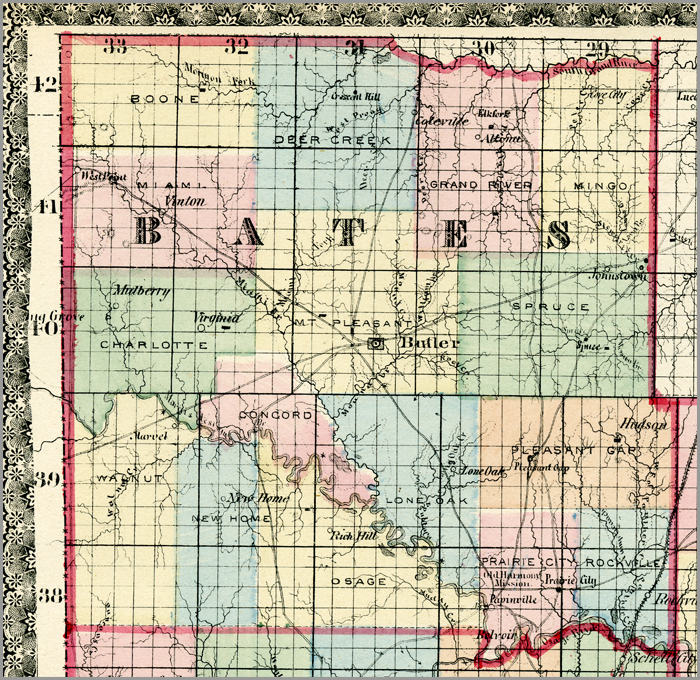Bates County, Missouri

- Formed: February 16, 1825
- County Population 1860: 6,773
- Slave Population 1860: 443
- Civil War Engagements- Affair at Hog Island, May 18, 1863
Image courtesy of Wilson’s Creek National Battlefield
Bates County, Missouri is located near the White River and the Marais de Cygnes (Marsh of the Swans) Fork of the Osage River. The other natural sources of fresh water include Deepwater, Marmon Fork, Mulberry, Panther, Walnut, Miami, and Muddy Streams, which supply abundant fresh water for raising livestock. Residents grew corn, oats, and wheat. Wild fruits, such as apples, cherries, pears, peaches, plums, apricots, and various wild berries are also abundant. The area has shale and clay deposits, which are a main component in brick-making.
At the time of the first non-Native American exploration, the French in the early 1700s, the Osage inhabited the Bates County area. Explorer Zebulon G. Pike traveled through the area in 1806. A missionary group, called Harmony Mission, came to Bates County in the early 1820s. They hoped to convert the Osage to Christianity. Harmony Mission included several families from multiple Christian denominations from New York and Pennsylvania. Most Harmony Mission members gradually returned to the east coast, as many became ill and their attempt at converting the Osage proved unsuccessful. Some of the missionaries chose to remain in the area permanently. Most other early settlers came from Virginia, Kentucky, Tennessee, Ohio, and Indiana, and settled along the woodlands bordering the streams in the area.
The land comprising Bates County was once part of several other Missouri Counties. These included: Lillard County, formed November 16, 1820, Jackson County and Lafayette County, formed February 16, 1825, and Van Buren County (later renamed Cass County) formed January 16, 1833. Bates County was established on January 29, 1841. It was named after Frederick Bates, who was Missouri’s second governor. The first county seat was named Papinville, but after Vernon County was formed in 1855, the town was no longer centered enough to be the county seat. The seat was moved to Butler.
In the 1850s, much controversy swirled around whether Kansas should enter the Union as a slave or a free state. There were many border raids between Bates County and bordering Kansas counties from 1854-1858. The majority of Bates County residents were pro-slavery and there was a larger slave population in Bates County than many other Missouri counties in the area, with 443 slaves documented on 1860 Census. When the southern states seceded and the Civil war began, most residents supported the Confederacy. Because Bates County bordered Kansas, border warfare, especially guerrilla warfare from both states, continued to be a problem.
On September 22, 1861, Osceola, Missouri, in neighboring St. Clair County, was destroyed during a Union raid on Confederate troops. The Confederates hid in the homes around town and Union troops burned all of them in order to drive the Confederates out. The courthouse in Butler was also burned during the war. The main Bushwhacker band, led by William C. Quantrill, was notorious in the area. Guerrilla warfare became so serious that on August 25, 1863, Brigadier General Thomas Ewing issued Order Number 11, which exiled everyone in Bates, Jackson, Cass, and Vernon Counties were from their homes. If a family proved loyal to the Union, they were allowed to stay near military base or anywhere in Kansas that was not near the Missouri-Kansas border. Residents could take all they could carry. After the residents left, the Union troops utilized all crops and livestock, and burned many homes. Order Number 11 intended to leave Bushwhackers with no resources, but it also left Bates County residents who were not part of guerrilla bands displaced and without means of surviving. The Battle of Island Mound occurred on October 29, 1862 at Toothman Farm in Bates County. The 1st Kansas Colored Infantry successfully defeated the confederate soldiers even though they were greatly outnumbered, forcing them to retreat. The Affair at Hog Island, a small skirmish in Bates County, took place on May 18, 1863, between Captain C.F. Coleman and a Confederate Band.
After the war, the county was mostly depopulated due to the war’s destruction and the forced evacuation in 1863. Residents gradually returned. Reconstruction was aided when the railroad came to the area in the 1870s, bringing many new people to the area.
 Browse all collections in Bates County
Browse all collections in Bates County
- Consulted:
- W.O. Atkeson, History of Bates County, Missouri (Topeka, KS: Historical Publishing Company, 1918).
- http://www.batescounty.net/bates_county.htm












